Flamethrower PM-1, second variant (Czechoslovakia)
Recall, as a basis for a flamethrower tank "PM-1" was selected tracked chassis of the self-propelled artillery Jagdpanzer 38 Hetzer, previously developed in the interests of the German army. Through some design changes, the existing self-propelled gun was "turned" into a flamethrower tank. In the future, it was planned to build 75 of these machines, the last of which were to go to units no later than the end of 1950. Nevertheless, the project was faced with technological problems, due to which all the deadlines were hopelessly frustrated.
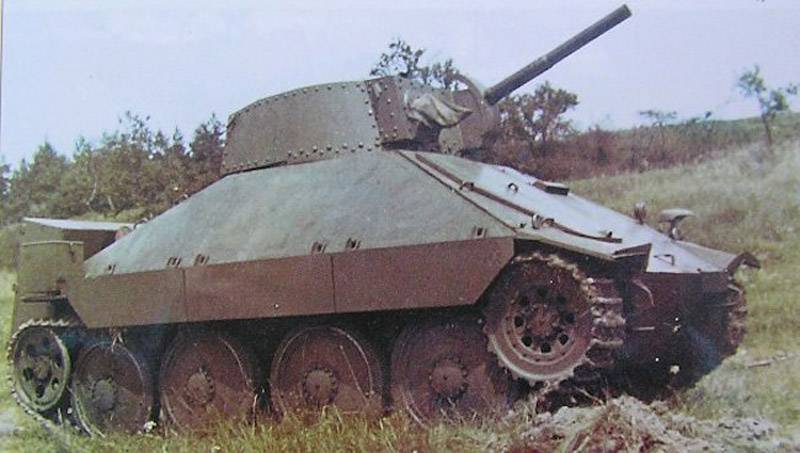
The third prototype of the tank PM-1 (the second, built on the updated project). Photos of Tanks-encyclopedia.com
During the tests, forcedly transferred to the 1951 year, the developers of the PM-1 project and the military revealed a number of serious flaws in the existing design. The flamethrower tank had acceptable mobility characteristics, but its fighting qualities left much to be desired. The firing range of the fire mixture was only 60 m. In addition, when discharging from the hose, the flammable liquid flew apart, exposing the vehicle and its crew to danger. Another serious drawback of the project was the location of the tanks for the fire mixture. Several tanks were inside the reserved volume, another one was placed outside the body in an additional armor cover. Because of these layout features, the flamethrower tank risked catching fire at the very first penetration of the armor by a projectile.
According to the test results of the first prototype of the PM-1 tank, a fundamental decision was made to continue the work on the project. At the same time, it was now necessary to change the design of various devices and units, which caused the claims. Other nodes that suit the customer could be left without significant changes. It was assumed that the new flamethrower tank will be created by processing the existing project. For this reason, the new development has not received a new designation. The improved project was again called PM-1. This feature of the two projects should be taken into account in order to avoid possible confusion.
The development of a new project was carried out by the Military Technical Institute Vojenský Technický Ústav (VTU). This organization has already had experience in creating armored vehicles of various classes. In addition, it was VTU specialists who had previously developed the first version of a flamethrower tank, which is why they were entrusted with the further development of the project. At the stage of construction of experimental equipment and future serial assembly to the project it was planned to attract new organizations, primarily the company Českomoravská Kolben-Daněk (ČKD).
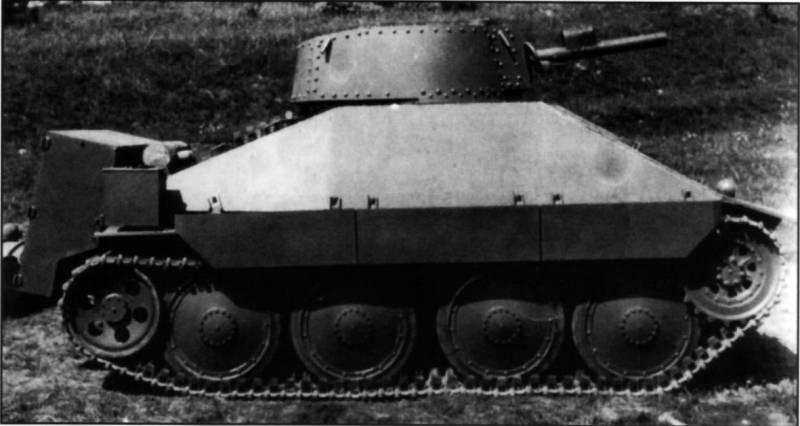
It was proposed to install the turret of the light tank LT vz.38 on the hull of the SAU Hetzer. Photo Strangernn.livejournal.com
The armored hull and the chassis of the first version of the flame-thrower tank, which were slightly modified elements of the SAU “Hetzer”, did not cause any complaints from the customer, thanks to which they were decided to be used in the new project. It was decided to replace the tower and create a new version of the flamethrower with enhanced characteristics. It was also proposed to radically recycle the storage and supply of fire mixture: while maintaining the general principles of operation, it was necessary to use other units with a different location.
In the second version of the PM-1 project, the existing hull was retained, which was a modified design of the existing self-propelled gun. The frontal projection of the vehicle was mainly protected by armor plates 60 mm thick, placed at an angle to the vertical. In the large upper frontal part there was an embrasure for the installation of the gun, which should have been covered with an appropriately shaped 50-mm plate. In the course of the future mass production it was proposed to remove the armor for this from the captured equipment.
The hull had vertical lower side plates and inclined upper ones, which formed developed fencing niches. The thickness of all the onboard parts was 20 mm. The feed was protected by an 20-mm top sheet and bottom part 8 mm thick. The hull roof was 10 mm thick. The first version of the flamethrower tank was to be equipped with an additional armor unit on the right side of the hull. When creating an improved flamethrower tank from this casing refused.
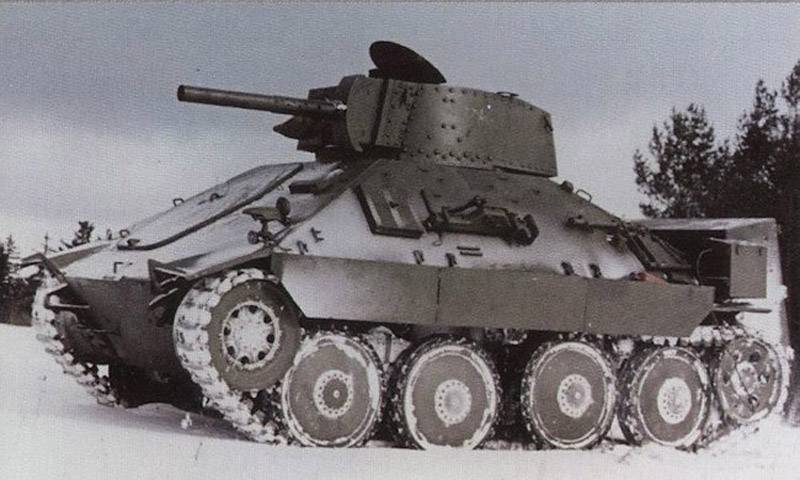
Experienced flamethrower tank in tests. Photos of Tanks-encyclopedia.com
The first PM-1 flamethrower tank had a relatively simple layout of the internal hull volumes based on existing ideas and solutions. The front part of the body was given under the placement of transmission units. Behind them was a manned compartment, turned out to be a department of command and a fighting compartment with a swivel tower. The stern housed the engine compartment, which was connected to the front transmission devices with a propeller shaft.
The Praga AE gasoline engine with 158 hp power should have been in the rear of the hull. With the engine connected manual transmission Praga-Wilson with five forward gears and one rear. The transmission was divided into two blocks, placed in the feed and bow compartments of the hull. The front units were designed to transmit engine torque to the drive wheels.
The design of the chassis for the flamethrower tank was completely borrowed from the serial self-propelled gun. Thus, the units developed as part of the project of the light tank LT vz.38 were to be used once again. On each side were placed four large support rollers. The rollers were connected in pairs with the help of carts, the latter were completed with leaf springs. In front of the hull were driving wheels of increased diameter, in the stern - reduced guide wheels.
In the original version of the PM-1 project, it was proposed to equip the tank with a turret, in which everything necessary should be installed weapon. The first prototype of the tank received a conical turret with two ball mounts for the fire engine of the flamethrower and the auxiliary machine gun. This design has not justified itself, as a result of which it was proposed to use a different version of the tower. To reduce the cost of creating the project and the future mass production of the new tower was proposed to borrow from the old technology.
On the pursuit of the hull roof, it was proposed to install the turret of the light tank LT vz.38, which was mass-produced for a long time. The tower of this version had a box-shaped frontal part with devices for installing weapons and a mask, as well as a conical central unit and a developed feed niche. The tower was made of armor plates with a thickness of 15 mm (feed and side) to 25 mm (forehead and mask), mounted on the frame with rivets.
For use in the flamethrower tank design, the tower of the existing design had to be slightly modified. Some internal devices were reworked. In addition, the commander’s turret with viewing devices was removed from the roof. The turret was removed due to the need to reduce the overall height of the machine. For some reason, this parameter was considered important by the machine, and after installing the new turret, the height of the tank could exceed 2,6 m, which did not suit the customer.
In the central part of the tower’s front there was a rocking installation for the main armament. Instead of the standard for the Czechoslovak light tanks 37-mm guns, on this installation it was proposed to mount the fire engine of the flamethrower of the new model. It was possible to control and direct these weapons with the help of standard armament drive drives. To the left of the flamethrower was a twin machine gun. Instead of a weapon of their own Czechoslovak development, it was proposed to use the Soviet machine gun DT caliber 7,62 mm.
Used in the first version of the PM-1 tank, the Flammenwerfer 41 flamethrower showed insufficient characteristics, due to which the new armored vehicle was to receive updated weapons. Konstrukta has created an improved version of the jet flamethrower, originally adapted for installation on a combat armored vehicle. It was proposed to carry out the fire mixture through a pipe with an internal diameter of 14 mm installed inside a larger casing. In the muzzle of the hose was a pyrotechnic system of ignition of the liquid.
One of the main complaints about the flamethrower tank of the first version concerned the placement of the ammunition tanks inside the armored corps. In some circumstances, such a design machine could lead to her death. In the new project it was proposed to move all potentially dangerous components outside the habitable compartment. The structure of the storage and supply of fire mixture included three metal tanks with a total capacity of 1000 l. These tanks were proposed to be placed in a special rectangular armor casing fixed at the stern of the tank. The casing had walls 8 mm thick, which made it possible to protect tanks from small arms bullets and shell fragments.
In addition to the three tanks for flammable liquids, seven cylinders for compressed nitrogen should be installed in the stern casing. Gas under pressure of at least 50 atmospheres had to squeeze the fire mixture out of the tank and push it through the hoses to the hoses, ensuring a further release towards the target.
According to reports, in the first project PM-1 was planned to hit the target with the help of burning gasoline. The flamethrower company Konstrukta had to use a different flammable liquid. The fire mixture for the new tank should have been 80% composed of gasoline and 20% of the composition of BTEX, which was a mixture of benzene, toluene, ethylbenzene and xylenes. The new fire mix differed from gasoline in a number of parameters, which made it possible to improve the throwing characteristics and improve the overall performance of the flamethrower.
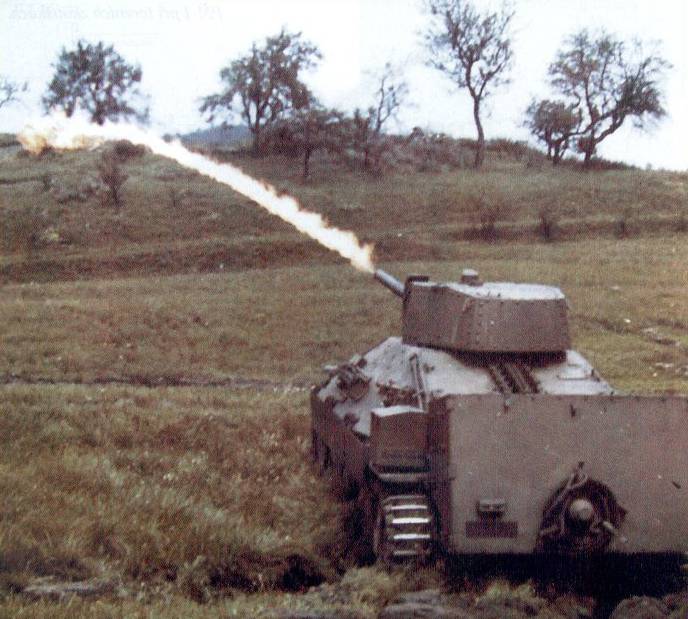
Fire Shot Photo by Ftr.wot-news.com
The flamethrower tank of the second version should not differ from the first prototype in its dimensions and mass. The length of the vehicle was 4,87 m, width - 2,63 m, height - 2,55 m. The combat weight remained at the level of 17 m. The 158-strong engine allowed to accelerate to the highway to 40 km / h and to overcome at one refueling to 180 km. The car was to be driven by a crew of two, a driver and a gunner commander.
The development of the second version of the PM-1 project started in 1951 year. Until the end of this year, the VTU Institute completed the preparation of documentation and transferred it to the ČKD plant for the construction of an improved prototype. The assembly of the new armored vehicle continued until the spring of the 1952 year. Information about further work using the first prototype tank of the second version (or the second one in the framework of the entire program) in different sources is different. According to one data, an experienced flamethrower tank was put to the test, but did not show outstanding results, because of which design work continued and led to the construction of a new prototype. According to other information, this prototype was not tested at all. Instead, the updated project on tests was originally presented by the third prototype machine.
Despite the lack of accurate data on testing an experienced flamethrower tank of the second version, there is information about the characteristics of its weapons. By improving the design of the flamethrower and using a new flammable liquid, the firing range was able to reach the 120 m. Thus, the fire mixture flew at twice the distance than in the case of the first tank equipped with the Flammenwerfer 41 system. It was also found that by changing the design of the flamethrower, increasing the pressure of compressed gas and processing the composition of the fire mixture, the firing range can be further increased.
In March, 1953, another experienced tank with a flamethrower in the turret, came out of the assembly shop. It was built on a modified draft of the second version. This machine differed from the previous prototype by a different storage system and supply of fire mixture. While maintaining the overall layout of the units with simultaneous refinement of individual devices, the firing range was increased to 140 m. Calculations showed that further development of the project will again increase the range of liquid ejection.
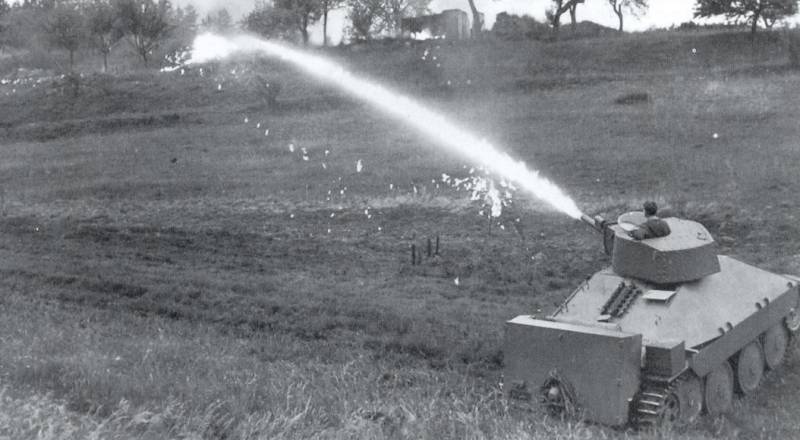
The firing range, depending on the type of fire mixture, could reach 120-180 m. Photo Ftr.wot-news.com
During the tests, it was found that the third prototype of the PM-1 tank, differing from its predecessors by an increased range of fire, has some drawbacks. First of all, the problem was not very successful system of refueling the feed tanks of the fire mixture. It took about an hour to fill 1000 with liquid, which could have a negative impact on the operation of serial equipment. At the same time, the proposed placement of tanks was approved. Tanks with flammable "ammunition" defended the entire body of the machine, as well as its own 8-mm armor. In the event of the defeat of the tanks, the fire did not threaten the crew: even with the negative development of events, the driver and the commander could manage to leave the burning tank.
By the end of 1953, the authors of the project PM-1 from the VTU Institute managed to achieve new successes, however, by this time the customer represented by the military department of Czechoslovakia began to doubt the need for further work to be continued. The development program of the flamethrower tank started back in 1946, but seven years after that was far from complete. The proposed design is rapidly becoming obsolete morally, and the concept of a self-propelled machine with a jet flamethrower that underlies the project became the subject of more and more disputes.
Also, when deploying mass production of technology could manifest a problem in the form of the lack of the required components. Shells and chassis for flamethrowing tanks could be taken from the remaining Jagdpanzer 38 ACS, while the “resource” of the towers was seriously limited. As of the beginning of the fifties, Czechoslovakia had an insufficient number of light tanks LT vz.38, which did not allow using them in the new project as a source of necessary units. A new start to the production of such products was impractical.
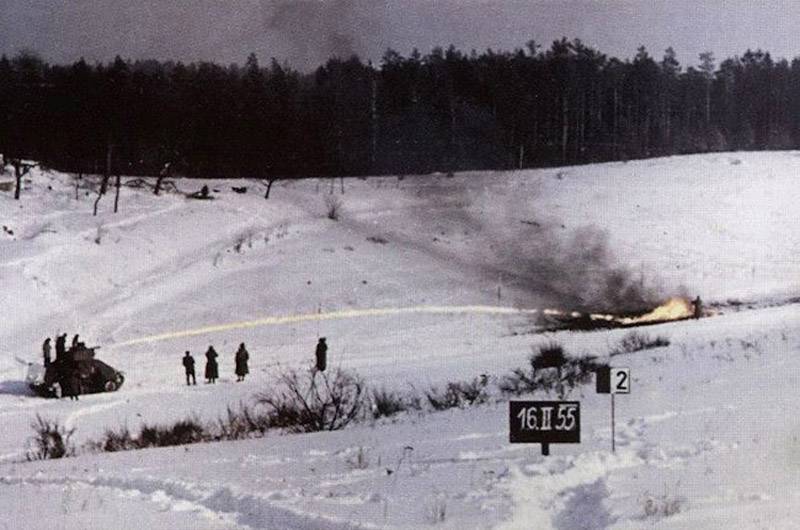
Field Test, 16 February 1955 g. Photo by Tanks-encyclopedia.com
Nevertheless, VTU and related organizations continued to develop the PM-1 project. With the help of new flamethrower modifications and changes in the fire mixture, the range of liquid ejection was brought to the 180 m.
The PM-1 project continued until the 1956 year. During the ten years of development and improvement of the project, three prototypes were built: one according to the original project and two according to the improved one. After completion, the third prototype of the tank could become a benchmark for future production vehicles, but in practice it remained the latest model of its type.
By the mid-fifties, the Czechoslovak military had finally become disillusioned with the PM-1 project. The defense industry, despite all expectations, was unable to cope with the task in a short time, which is why the work on the project was seriously delayed. As a result, the military lost interest in the flamethrower tank, which could no longer fit into the modern structure of the fleet of armored vehicles of the armed forces. Further work on the project did not make sense. The project was closed, and all built prototypes soon went to the disassembly. In the 1956 year, they were not of interest even from the point of view of alteration in the ACS of the original appearance.
Shortly after the end of World War II, Czechoslovakia tried to use its own and "trophy" German experience in new projects of military equipment for various purposes. Some of these projects ended in success and allowed to re-arm the army. Other developments, in turn, did not produce the expected result. Thus, the PM-1 flamethrower project was developed and improved for ten years, after which it was closed for lack of prospects. The unacceptable duration of development, testing and refinement deprived the original car of the future.
On the materials of the sites:
http://tanks-encyclopedia.com/
http://armoured-workshop.com/
http://valka.cz/
http://ftr.wot-news.com/
http://strangernn.livejournal.com/
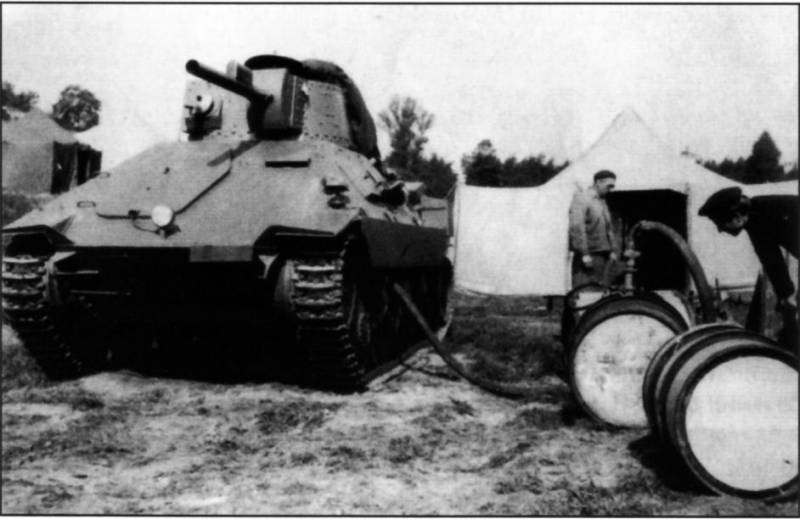
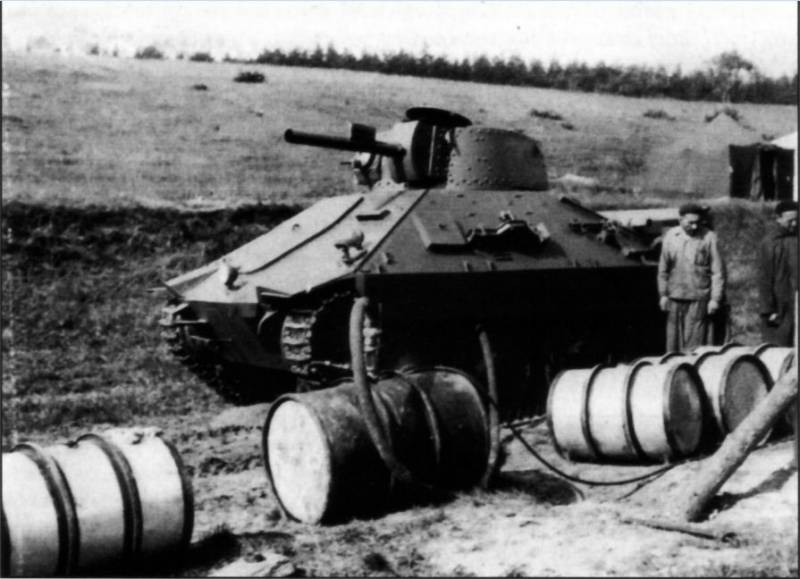
Information